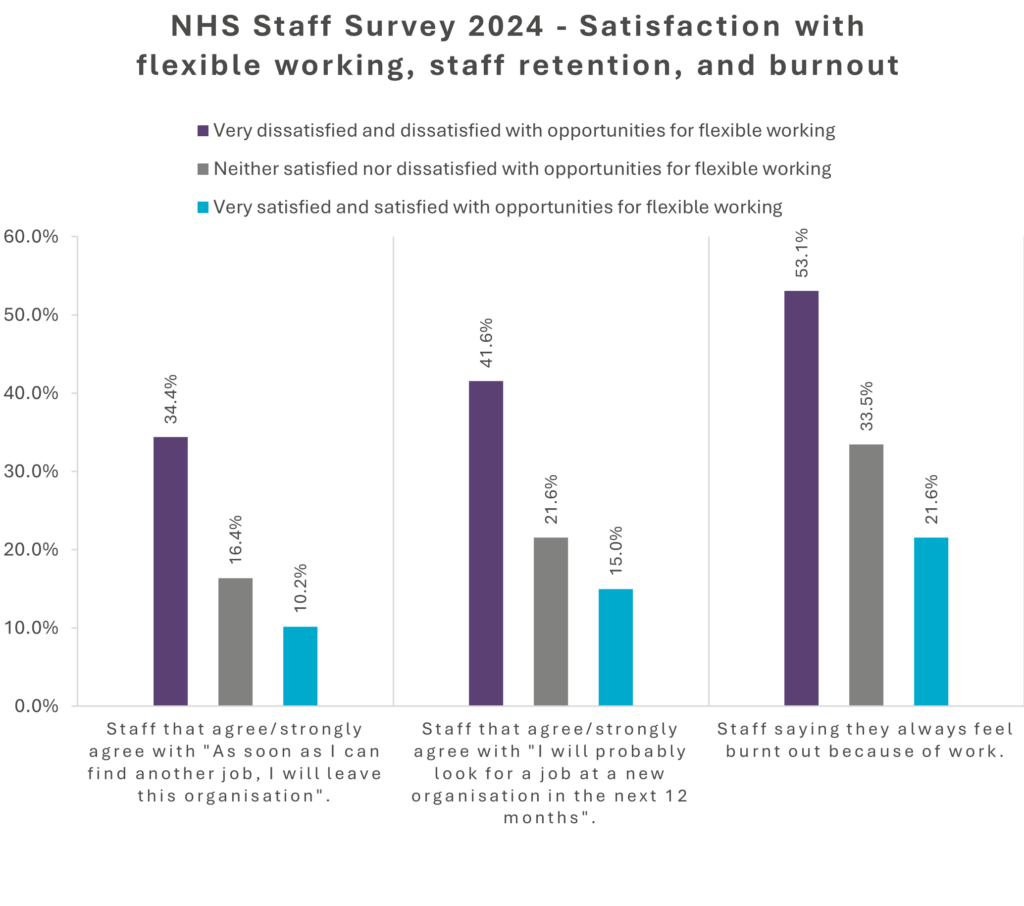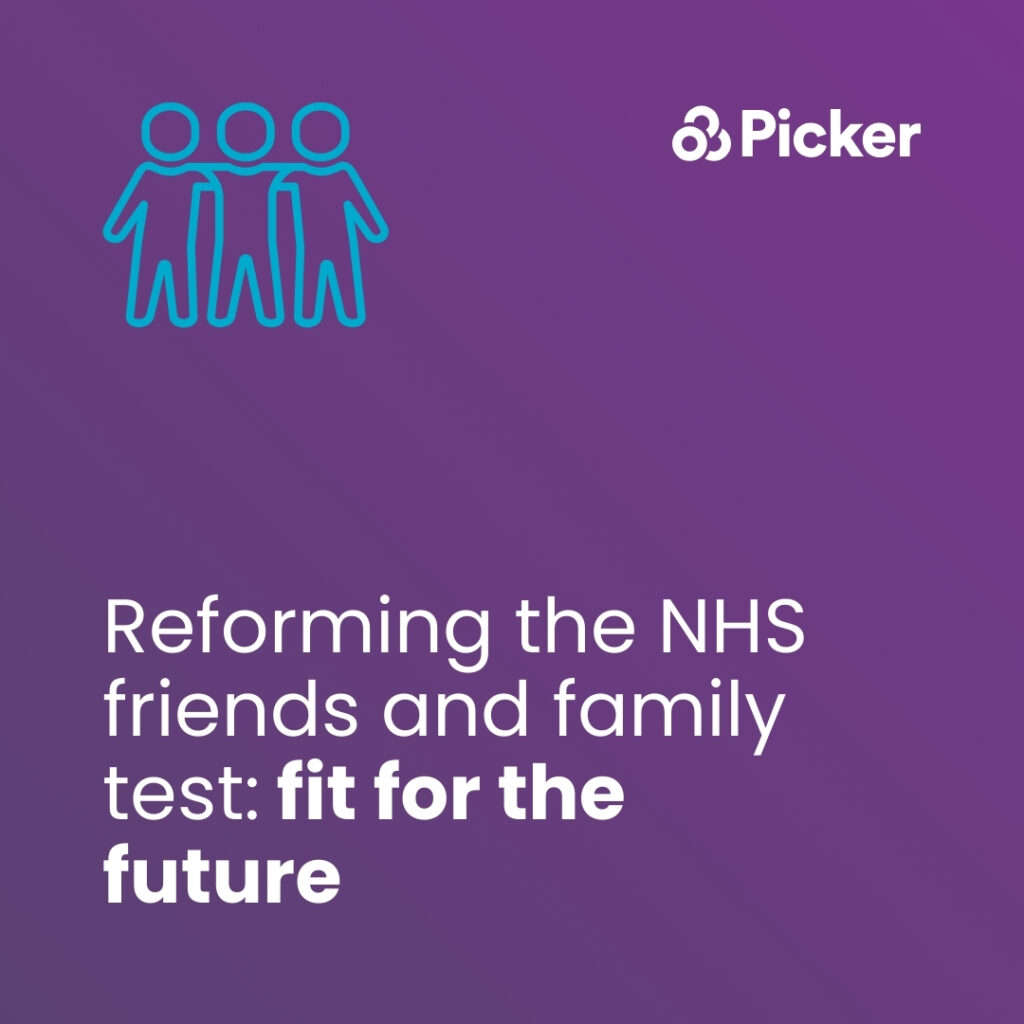Flexible Working in the NHS: Evidence from the 2024 Staff Survey
The NHS People Promise includes a commitment that ‘We work flexibly’. But are staff able to access flexible working opportunities in practice, and what difference does this make for people’s experiences overall? We take a closer look at 2024 NHS Staff Survey¹ results to find out.
Flexible working across the NHS
The People Promise element ‘We work flexibly’ states that working for the NHS shouldn’t mean having to sacrifice family, friends or interests – staff should be able to work predictable and flexible hours, with support to take time off when needed².
However, managers have to balance individuals’ preferences for flexible working with the needs of colleagues, maintaining safe staffing levels at all times, and ensuring that people using the service have positive experiences³.
The National flexible working people policy framework⁴ outlines how this should work in practice, providing guidance both to staff wanting to work flexibly and to managers. This year, NHS England also released an e-learning programme to help embed flexible working across the NHS⁵.
But how is this working for staff?
In the 2024 NHS Staff Survey, we asked four questions that contribute to an overall People Promise score, ‘We work flexibly’ – two are about flexible working and two are about balancing work and home life⁶. ‘We work flexibly’ is scored between zero and 10, with a higher score indicating more positive responses.
In 2021, the national ‘We work flexibly’ score was 6.05, which has increased to 6.31 in 2024⁷. However, most of the increase occurred between 2022 (6.09) and 2023 (6.28).
In 2024, more than half of respondents gave positive answers to each of the four questions. Most (71.3%) said they can approach their immediate manager to talk openly about flexible working, and 57.7% said they are ‘satisfied’ or ‘very satisfied’ with opportunities for flexible working. More than half of respondents (56.6%) said they achieve a good balance between work and home life, and 50.3% said they ‘agreed’ or ‘strongly agreed’ that their organisation is committed to helping them balance work and home life.
Flexible working opportunities and staff retention
Data from the Staff Survey also shows how important opportunities for flexible working are, both to staff retention and preventing burnout.
Over three times as many (34.4%) staff that were dissatisfied with opportunities for flexible working agreed that as soon as they can find another job, they’ll leave their current organisation, compared to those satisfied with opportunities for flexible working (10.2%).
Almost three times as many (41.6%) staff that were dissatisfied with opportunities for flexible working agreed they will probably look for a job in the next 12 months, compared to those that were satisfied (15.0%).
Finally, more than twice as many (53.1%) staff that were dissatisfied with flexible working opportunities said that they often or always feel burnt out because of work, compared to staff that were satisfied with opportunities for flexible working (21.6%).

Flexibility for those who need it most
Flexible working arrangements can be particularly beneficial for disabled people or those with long-term health conditions⁸, as well as for people with caring⁹ or childcare responsibilities¹⁰.
Staff Survey data shows that, for people with childcare responsibilities, this flexibility is working. Their ‘We work flexibly’ score was higher than colleagues without childcare responsibilities (6.55 vs. 6.17). Their responses were also higher across all four individual questions, including:
- 63.7% saying they are satisfied or very satisfied with opportunities for flexible working compared to 53.8% of those without childcare responsibilities.
Scores from disabled people or staff with a long-term health condition were worse across each People Promise score, including for the ‘We work flexibly’ score (5.97 vs. 6.44). Their responses were lower across all four individual questions, including:
- 53.3% vs. 59.4% saying they are satisfied or very satisfied with opportunities for flexible working.
- 49.3% vs. 59.4% saying they achieve a good balance between work and home life.
We see a similar pattern for those with caring responsibilities, although the gaps are slightly smaller – e.g., 6.22 vs 6.37 for the ‘We work flexibly’ score.
Looking ahead
Staff retention has improved, thanks in part to flexible working arrangements¹¹, and is now the best it has been in over a decade. The upcoming ten year plan, which will be delivered by NHS staff, represents an opportunity to continue this trend while focusing on supporting those who currently report dissatisfaction with their access to flexible working opportunities.

